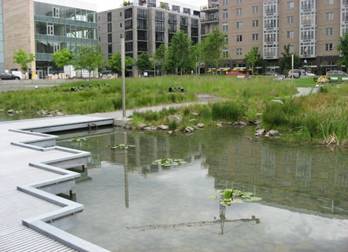Collaboration and Partnerships
Note: EPA no longer updates this information, but it may be useful as a reference or resource.
Managing Wet Weather with Green Infrastructure
EPA Office of Water
Geographic location or area of activity: National effort led by EPA HQ
Description of activity: This effort is intended to manage wet weather runoff, including stormwater, urban runoff and combined sewer overflows. Contemporary development patterns cover large areas of the ground with impervious surfaces such as roads, driveways and buildings. Once such development occurs, rainwater cannot infiltrate into the ground; therefore, it runs offsite at unnaturally high rates and volumes. The runoff scours streams and erodes stream banks, causes large quantities of sediment and other entrained pollutants to enter the waterbody each time it rains, and destroys or impairs the aquatic habitat of waterbodies and their riparian areas. Furthermore, these same high rates cause older cities that have combined sewage and stormwater pipes to overflow and bypass sewage treatment plants, resulting in highly polluted discharges.
These problems can be eliminated or greatly ameliorated through a set of practices known as low impact development or, more broadly, “green infrastructure.” These practices reduce or eliminate runoff by applying one or more of three fundamental processes: infiltration, evapo-transpiration and reuse of the water.
On March 5, 2007, Assistant Administrator Benjamin Grumbles signed a memorandum entitled “Using Green Infrastructure to Protect Water Quality in Stormwater, CSO, Nonpoint Source and other Water Programs.” On April 19, 2007, Administrator Stephen Johnson co-signed a “Green Infrastructure Statement of Intent,” together with the National Association of Clean Water Agencies, Natural Resources Defense Council, Low Impact Development Center and Association of State and Interstate Water Pollution Control Administrators.
Since then, OW has worked closely with other EPA offices, the signatories listed above and many other interested parties to develop a long-term strategy and shorter term actions to implement the Statement of Intent. Action items deal with the need for research, outreach and communications, tools, Clean Water Act regulatory support, economic viability and funding, demonstration and recognition, and partnerships and promotion. Many of the listed action items are already in progress, and many more will begin in the next few months. The challenges, available solutions, case studies and more are discussed at www.epa.gov/npdes/greeninfrastructure.
An agreement was reached with the District of Columbia in December 2007 to implement major green infrastructure enhancements to the storm water management program to protect the Potomac River, Anacostia River and Rock Creek through the use an EPA-sponsored mediation process. The District agreed to undertake innovative measures to prevent storm water runoff at the source, with the extensive use of natural systems such as green roofs, trees cover and vegetated swales and buffers. The District will be pursuing goals for a 20% coverage of green roofs throughout the city, storm water regulations which require low impact development techniques as a first option for development and redevelopment, and tax credits or other incentives for installation of green management practices. This Agreement with EPA is memorialized in the Storm Water Management Plan which is an enforceable element of a Clean Water Act permit to the District for storm water control.
Interagency partners: EPA is working with a broad set of Federal partners on Green Infrastructure issues, including the Departments of Defense, Agriculture, Transportation, Commerce, and Interior. EPA is also working with ASIWPCA, and individual states, including West Virginia, Tennessee, and Massachusetts. Through the Section 319 program, EPA provides funding to states and tribes to demonstrate and promote such practices as green roofs, rain gardens, bio-swales, rain barrels, and pervious pavements.
Local partners: Counties (e.g., Prince Georges County, MD; King County, WA; ); cities (e.g., Philadelphia, PA; Portland, OR; Seattle, WA; District of Columbia); and innumerable community groups and nonprofits throughout the United States that are implementing practices or educating their members or their communities to implement practices. One example of just some of our partners is the list of partners who have asked to be listed on our website as supporters of the green infrastructure initiative: http://cfpub.epa.gov/npdes/greeninfrastructure/gisupport.cfm.
Activity URL: www.epa.gov/npdes/greeninfrastructure

This pond in Portland, OR, uses no city water. Instead, it is fed
by rainwater that is captured from the entire park and filtered first
![[logo] US EPA](../gif/logo_epaseal.gif)